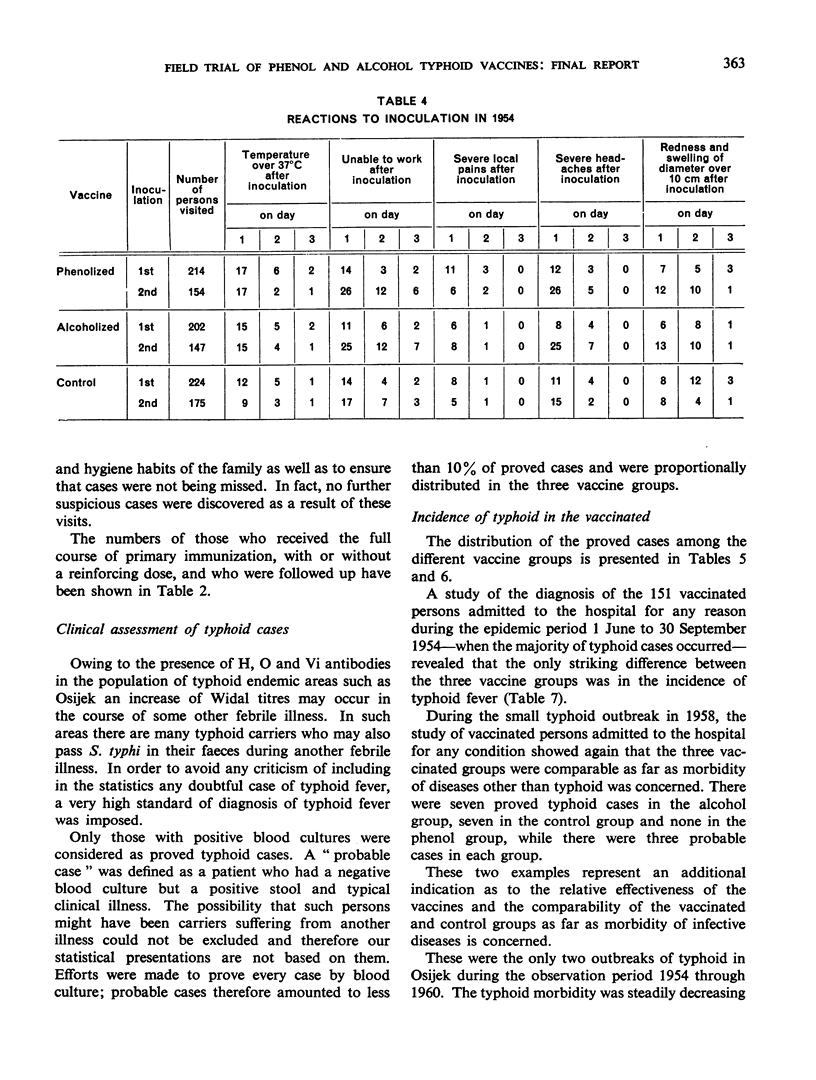Abstract
In order to determine the effectiveness of anti-typhoid vaccines in man a controlled field trial, the first of its kind, was organized in 1954-60 in the town and district of Osijek, Yugoslavia. Heat-killed, phenol-preserved and alcohol-killed, alcohol-preserved anti-typhoid monovaccines were used, with phenolized dysentery vaccine as a control. Some 36000 volunteers were allocated at random into three comparable groups: a phenol-vaccine group, an alcohol-vaccine group and a control group. Immunization consisted of a primary course of two injections. A reinforcing dose was given a year later. The effectiveness of the vaccines was measured by comparing specific morbidity in the three groups, and for greater accuracy only bacteriologically proved typhoid cases were taken into consideration in the statistical analysis. In addition, some 11 000 persons were vaccinated in 1955; these were divided at random into two groups, which received phenolized and alcoholized vaccine respectively; there was no control group. It was found that phenolized vaccine gave relatively high protection while alcoholized vaccine was of little, if any, efficacy. The efficacy of phenolized vaccine was of rather long duration. These field results obtained on man are not in agreement with the results of laboratory tests known at present. Neither laboratory assays on mice nor serological tests on man could be correlated with the results of the field trial. For this reason further studies are necessary in order to determine the value of various other types of anti-typhoid vaccines and to develop reliable laboratory tests for the measurement of the potency of anti-typhoid vaccines.
Full text
PDF












Selected References
These references are in PubMed. This may not be the complete list of references from this article.
- Boyd J. S. Enteric Group Fevers in Prisoners from the Western Desert. Br Med J. 1943 Jun 12;1(4301):719–721. doi: 10.1136/bmj.1.4301.719-a. [DOI] [PMC free article] [PubMed] [Google Scholar]
- COCKBURN W. C. Large-scale field trials of active immunizing agents; with special reference to vaccination against pertussis. Bull World Health Organ. 1955;13(3):395–407. [PMC free article] [PubMed] [Google Scholar]
- COCKBURN W. C. The early history of typhoid vaccination. J R Army Med Corps. 1955 Jul;101(3):171–185. [PubMed] [Google Scholar]
- CVJETANOVIC B. Controlled field trials of prophylactics (with special reference to typhoid vaccines). J Hyg Epidemiol Microbiol Immunol. 1961;5:7–21. [PubMed] [Google Scholar]
- Felix A. A New Type of Typhoid and Paratyphoid Vaccine. Br Med J. 1941 Mar 15;1(4184):391–395. doi: 10.1136/bmj.1.4184.391. [DOI] [PMC free article] [PubMed] [Google Scholar]
- HOLT R. L. Current status of immunization procedures; typhoid fever. Am J Public Health Nations Health. 1948 Apr;38(4):481–484. doi: 10.2105/ajph.38.4.481. [DOI] [PMC free article] [PubMed] [Google Scholar]
- Report on Certain Enteric Fever Inoculation Statistics. Br Med J. 1904 Nov 5;2(2288):1243–1246. [PMC free article] [PubMed] [Google Scholar]
- Wright A. E., Semple D. Remarks on Vaccination against Typhoid Fever. Br Med J. 1897 Jan 30;1(1883):256–259. doi: 10.1136/bmj.1.1883.256. [DOI] [PMC free article] [PubMed] [Google Scholar]


